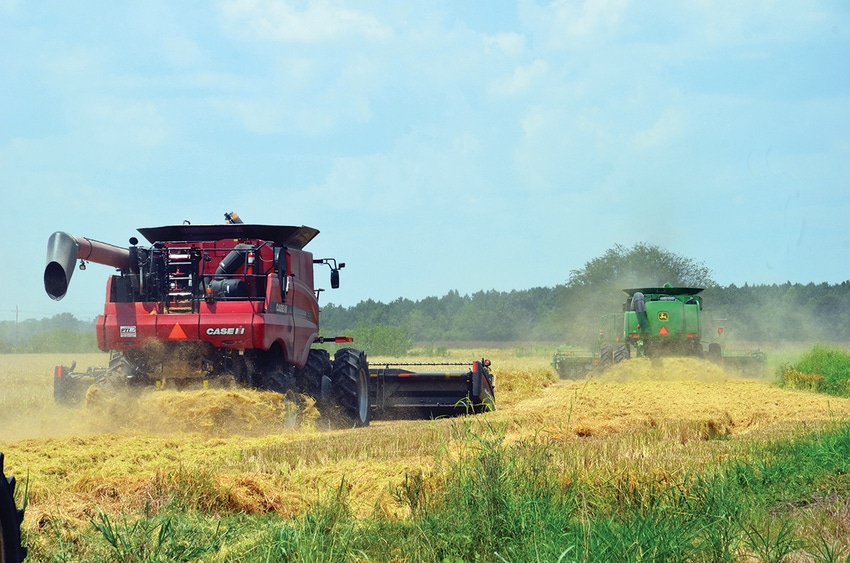March 31, 2016

Rice
USDA’s March 31 Prospective Planting report indicates 2016 long grain rice planting intentions of 2.452 million acres, up 31 percent from 2015. This compares to the previous five-year average of 1.93 million long grain acres and a previous 10-year average of 2.141 million acres.
Bottom line: This implies that the U.S. long grain rice market needs additional demand, especially from outside the Western Hemisphere.
• Depending on the farm, its financial depth, etc., I would stay with a reasonably typical crop rotation. I really do not see rice having a major economic advantage over soybeans and corn given the anticipated long grain rice acreage expansion over 2015.
• USDA, in its Feb. 26 2016 Rice, Grains and Oilseeds Outlook presentation delivered at the this year’s USDA Outlook Forum, projected total 2016 U.S. long grain rice acreage at 2.08 million acres or 240,000 acres more than last year’s 1.84 million acres. It projected a 2016-17 marketing year average price of $11.30 per hundredweight or $5.09 per bushel, which is the same as its current 2015-16 price expectation.
• Without expected additional demand for U.S. long grain rice near term and a projected 2016 U.S. long grain rice acreage of 2.452 million acres, the potential increased production will likely weigh heavily on U.S. long grain rice prices.
Upland cotton
USDA’s upland cotton planting intentions show a current expectation of 9.562 million acres, up 11 percent from 2015. The average trade forecast is around 9.4 million acres. This compares to the previous five-year average of 11,185,400 cotton acres and a previous 10-year average of 11.048 million acres.
Cotton prices appear to have the potential of making a price bottom around 50 cents. The 2016-17 cotton marketing period has real price potential, but first we must find a multi-year price bottom followed by a consolidation period.
Soybeans
USDA’s soybean planting intentions show a current expectation of 82.236 million acres, down less than 1-percent from 2015. The average trade forecast is 83 million acres.
This compares to the previous five-year average of 79 million soybean acres and a previous 10-year average of 76.585 million acres.
Global oilseed fundamentals and global economic softness will continue to create pricing challenges until a multi-year price bottom is reached.
Corn
USDA’s corn planting intentions estimates show a current expectation of 93.601 million acres, up 6 percent from 2015. The average trade forecast was 90 million acres.
This compares to the previous five-year average of 92.638 million corn acres and a previous 10-year average of 89.560 million acres.
Some say corn has already found a price bottom and possibly under more normal past global growth that would be the case. Even without this planted acreage expectation, today’s global uncertainty is being driven by an array of global economic and political factors that are weighing heavy on this market like: individual country growth (China being a good example); currency uncertainty (for example, some believe the dollar has topped, but I anticipate the best case for the dollar near term is sideways price action); globally central banks are creating huge amounts of uncertainty which is leading to reoccurring market price squeezes; and the list goes on.
Sorghum
USDA’s sorghum planting intentions show a current expectation of 7.216 million acres, down 15 percent from 2015. This compares to the previous five-year average of 7.077 million sorghum acres and a previous 10-year average of 6.999 million acres.
Closing comments
• My advice to producers is much the same as this time last year. Be very respectful of the dangerous economic undercurrents associated with the global economic slowdown and bearish underlying rice, cotton, and grain market fundamentals.
• No one farming today has dealt with a farm business environment this dangerous and complex. Uncertainty rules near term, so producers, marketers, and agribusiness should be respectful of our domestic and global economic setting.
• The economic dangers and price uncertainty our producers face will remain until a multiyear price bottom is in place. Presently, it does not appear that rice, cotton, and grains have put in a multi-year bottom; therefore, just as in 2015, producers and supporting infrastructure should continue their super conservative farm manager ways and make business adjustments that will allow a possible positive cash flow.
All of the above has led to not only complex price charts, but dangerous levels of price volatility.
For additional details, download USDA’s U.S. and State Long Grain Rice Plantings, U.S. Cotton, Soybean, Corn and Sorghum Plantings and USDA’s Prospective Plantings, Grain Stocks, and Rice Stocks – Executive Summary.
Robert Coats is a professor, Department of Agricultural Economics and Agribusiness, Division of Agriculture, University of Arkansas System. Contact him at [email protected].
About the Author(s)
You May Also Like






